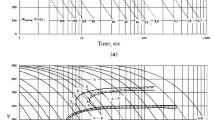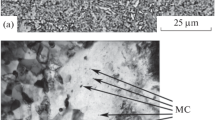Oil and gas production casing and compression pipes used for structures in oil and gas deposit structures contaminated with a high concentration of hydrogen sulfide should have alongside high strength and cold resistance good sulfide stress corrosion cracking resistance. Medium carbon steels alloyed with chromium and molybdenum are used extensively for such products. After quenching and tempering in the temperature range 680–720ºC these steels possess increased yield and tensile strengths along with good ductility. Alloying with molybdenum and vanadium provides a marked increase in sulfide stress corrosion cracking resistance with an increase in tempering temperature in the range indicated.





Similar content being viewed by others
References
A. Di Schino, G. Porcu, M. Longobardo, and G. Turconi, Metallurgical Design and Development of C125 Grade for Mild Sour Service Application, Corrosion NACEexpo. 2006 / Paper No. 06125.
H. Asahi, Y. Sogo, M. Ueno, and H. Higashiyama, “Metallurgical factors controlling SSC resistance of high strength low alloy steels,” Corrosion, 45, 519 (1989).
H. Asahi and M. Ueno, “Effect of austenite grain size on SSC resistance of low alloy martensitic steels,” ISIJ Intern., 32, No. 9, 1021–1026 (1992).
P. J. Grobner, D. L. Sponseller, and W. W. Cias, “Development of higher strength H2S resistant steels for oil field application,” Mater. Perform., 14, No. 6, 33–43 (1975).
K. Kobayashi and K. Kondo, “Comparison of sour environmental severity by DCB,” in: Proc. Eurocorr’2015 (Graz, Austria. Sept. 6–10 (2015), pp. 115–123.
T. A. Dergach, “Scientific substantiation of selecting low-carbon steel and manufacturing technology for oil and gas pipelines with improved corrosion resistance,” in: Coll. Sci. Work “Construction, Materials Science, Engineering” Ser. Starodubov Readings (2012), pp. 202–210.
C. Mendibide and T. Sourmail, “Composition optimization of high-strength steels for sulfide stress cracking resistance improvement,” Corrosion Sci., 51, 2878–2884 (2009).
P. J. Grobner, D. L. Sponseller, and D. E. Diesburg, “The effect of processing variables on mechanical properties and sulfide stress cracking resistance of SAE 4135 steel modified with 0.75% Mo and 0.035 Nb,” Trans. ASME J. Eng. Industry, 98, No. 2, 708–716 (1976).
H. Asahi, D. Hirakami, and S. Yamasaki, “Hydrogen trapping behavior in vanadium added steel,” ISIJ Intern., 43, No. 4, 527–533 (2003).
OCTG Materials and Corrosion in Oil and Gas Production, Published by Sumitomo Metal Industries, April (2008).
R. Heidersbach, Metallurgy and Corrosion Control in Oil and Gas Production, Wiley (2018).
S. S. Gorelik, Yu. A. Skakov, and A. P. Rastorguev, X-Radiographic and Electron-Optical Analysis [in Russian], 3rd. ed., MiSIS, Moscow (1994).
S. S. Gorelik, S. V. Dobatkin, and L. M. Kaputkina, Metal and Alloy Recrystallization [in Russian], MISiS, Moscow (2005).
P. D. Odesskii and I. I. Vedyakov, Steel in Building Metal Structures [in Russian], Metallurgizdat, Moscow (2018).
M. A. Smirnov, V. M. Schastlivtsev, and L. G. Zhuravlev, Bases of Steel Heat Treatment [in Russian], Nauka i Tekhnologii, Moscow (2002).
K. Miyata, T. Omursa, T. Kushida, and Y. Komizo, “Coarsening kinetics of multicomponent MC-carbides in high-strength lowalloy steels,” Metallurgical and Materials Transformation A, 34A, No. 8, 1565–1573 (2003).
Author information
Authors and Affiliations
Corresponding author
Additional information
Translated from Metallurg, Vol. 66, No. 10, pp. 8–13, October, 2022. Russian DOIhttps://doi.org/10.52351/00260827_2022_10_8.
M. A Smirnov is deceased.
Rights and permissions
Springer Nature or its licensor (e.g. a society or other partner) holds exclusive rights to this article under a publishing agreement with the author(s) or other rightsholder(s); author self-archiving of the accepted manuscript version of this article is solely governed by the terms of such publishing agreement and applicable law.
About this article
Cite this article
Pumpyanskii, D.A., Pyshmintsev, I.Y., Maltseva, A.N. et al. Structure and Properties of Steel for Producing Hydrogen Sulfide Resistant Oil and Gas High Strength Pipes. Metallurgist 66, 1173–1180 (2023). https://doi.org/10.1007/s11015-023-01430-6
Received:
Revised:
Accepted:
Published:
Issue Date:
DOI: https://doi.org/10.1007/s11015-023-01430-6




